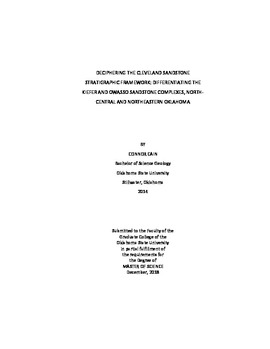| dc.description.abstract | The Cleveland sandstone interval contains a large Middle Pennsylvanian siliciclastic sediment dispersal system that covers a large portion of north-central Oklahoma including the Cherokee Platform, and host numerous oil and gas accumulations. The Cleveland sandstone interval, as used operationally by the petroleum industry, includes the stratigraphic section between the top of the Marmaton Group carbonates, frequently the Oologah Limestone (or "Big Lime") and the regionally extensive Checkerboard Limestone. Historically, most sandstones occurring in this interval were labeled "Cleveland" without considering their true age or stratigraphic position. Two primary Cleveland sandstone trends transect the study area: Kiefer and Owasso (Krumme, 1981). These sandstone complexes converge and intersect near the Cleveland Field Unit in Pawnee County, Oklahoma, which is operated by Mid-Con Energy. Mid-Con began a drilling program in 2011, followed by a secondary recovery (waterflood) program targeting the Cleveland sandstone. Discrepancies in production within the field prompted this study. One principal hypothesis was that the interaction between the Kiefer and Owasso sandstone complexes contributed to differences in rock properties that had an impact on production rates for wells in the Cleveland Field Unit, however, relating the production discrepancies to differentiated sandstones from the Kiefer or Owasso sandstone complex was not possible due to the complexities of these valleys. In order to test this hypothesis and evaluate the impact of the Kiefer and Owasso deposition on reservoir quality, detailed analyses of the stratigraphic framework, regional distribution, depositional lithotypes, and reservoir characteristics of the Kiefer, Owasso, and other Cleveland sandstones were completed. Findings of this study show that the Owasso sandstone complex occurs below the Nuyaka Creek Shale and is Marmaton aged, whereas the Kiefer sandstone complex is true Cleveland and in many cases fills a valley that eroded through the Nuyaka Creek Shale. Another key finding is that Marmaton carbonate paleotopography influenced Owasso complex distribution, but not the Kiefer, which is some cases appears to fill a deeply incised valley that eroded to the top and possibly removed Marmaton carbonate. | |
